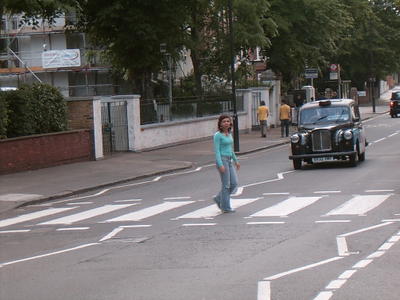
Eleonora was in London in June and asked him to take a picture at Abbey Road (at the exact point they crossed the geniuses at Liverpool for the cover of that album and legendary) as a memorial to his father. Apart brought me a key chain. Thanks will be given.
But as this blog is math, let me pose this problem (adapted from the version of EJ Barbeau, MS Klamkin, and WOJ Moser, Five Hundred Mathematical Challenges, Mathematical Association of America, 1995). Eleonora
travels regularly to London and invariably takes the train back home, which arrives at the station of the town where you live at 5 PM. At the same time does his driver picks it up quickly and takes her home. Eleonora One day earlier took the train and arrives at the station at 4 PM. Instead of calling his driver, or wait until 5, Eleonora we walked toward home. On the road is your driver who picks it up quickly and takes her home, which come 20 minutes earlier than usual. A few weeks later, on another day, Eleonora takes an earlier train and arrives at the station at 4:30 PM. Like last time, we walked toward home. As before, the road is your driver who picks it up quickly and takes her home. How many minutes earlier than usual this time Eleonora comes home?
Solution: This is a basic problem extremely difficult. Possibly because there is a strong tendency to see it as a problem of speed: one seeks to calculate the speed of the car and Eleonora (the assumption is obviously constant speed - as in any problem of speed). The framing speed is desperate for "missing data": no distance or time.
The framing that does the trick of lighting is the distance. But gaps in terms of time. I mean, the house is at a distance of t minutes of the season. And although we do not know the value of t, we can see that the reference point is the path of the driver, who goes to the station and back in 2t minutes - usually. Leaves at 5-t returns home at 5 + t. (An image that can help visualize the situation is to imagine a long string of 2t. So if you are over 20 minutes on the rope ...)
After thinking for a while it is possible that enlightenment comes, the driver found Eleonora 10 minutes from the station. And as it usually reaches the station 5 then found her at 4:50 PM. It follows that what runs the car in 10 minutes, Eleonora in 50 runs. (The speed ratio is 1:5)
So when Eleanor arrived at the station at 4:30, the driver found her at a distance of 5 minutes (by car) from the station, ie at 4:55 PM, and got home 10 minutes earlier than usual.
(Note also that the station at 5 PM is the benchmark against which to estimate distances in time order.)
Sincerely JMD in VL
0 comments:
Post a Comment